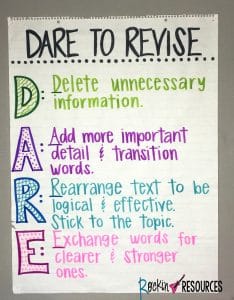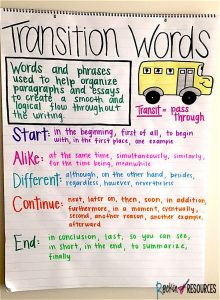Are you looking for ways to help your students revise their narrative essay? This post is one of several mini lessons on using the acronym D.A.R.E. (Delete, Add, Rearrange, Exchange) to revise and will focus on the A- ADD more details and ADD transition words in narrative writing. It is also a part of a series of writing mini lessons that scaffold through the writing process ideal for any writing curriculum.
When teaching students to revise for the first time in the school year, it is important to break down each of the ways into separate lessons. When students get a firm understanding of how to revise, it will make your future revision lessons a breeze! Many times students don’t write enough details in their story to keep a smooth flow. To also help with the flow of the story, students should find places to add transition words.
1. TEACH
Revisit the DARE anchor chart and tell students to only focus on A- Add more important details and transition words.
Not having enough details or lack of transition words will disrupt the flow of the story and confuse the reader. Tell students that transition words are words or phrases used to help organize paragraphs and essays to create a smooth and logical flow throughout the writing. The root word TRANSIT means to pass through. You want your readers to pass through your story with a smooth and logical flow!
For upper grades, your standards may require for you to introduce phrases and clauses.
A phrase is a group of words that may have nouns or verbs, but it does not have a subject.
- leaving behind the cat
- smashing into a wall
- before the next movie
- after the war
A clause is a group of words in a sentence that has a subject and predicate. Some clauses may stand alone as their own sentence!
- since she runs to music
- when the saints go marching in
- because he made the last shot
- I dislike bullies
2. MENTOR TEXT
One mentor text that can be used for transition words is Through Grandpa’s Eyes by Patricia MacLachian.
In the morning, the sun pushes through the curtains into my eyes.
When I open my eyes again, I can see Grandpa nodding at me.
After breakfast, I follow Grandpa’s path through the dining room in the living room.
Later, Nana brings out her clay to sculpt…
While she works, Grandpa takes out a piece of wood.
As we walk back to the house, Grandpa stops suddenly.
Before Grandpa leaves, he pulls the light chain above my bed to turn out the light.
3. MODEL
Within your class story, add more details and transition words. Talk out loud as you make your changes. It is a good idea to plan out where you can add these items in case you get stuck!
Example:
They reached a hard object. It was a bottle with another map. The map took the kids back on shore where they had to use a compass. They walked in that direction and came across a hurt dog by a bush. They came to an old barn.
Eventually they reached a hard object. They thought it was the priceless treasure but it was a glass bottle with another map. The map took the kids back on shore where they had to use a compass to find the direction southwest. They walked in that direction and came across a hurt dog by a thorny bush. The dog couldn’t walk so Hillary picked her up and carried her on their search. Then they came to an old abandoned barn.
4. TAKE NOTES
Students should add notes to their notebook: Why do I use a bus? Transit- means across, through. Transit is related to transportation. A bus is transportation. Get it? Get your writing across to your readers. Move through your story smoothly!
5. APPLY
Students should apply this particular way to revise by going through their own rough drafts and adding details and transition words. Allow them to use their notes, list of transition words, or any other resources to guide them.
6. SHARE
Students should share their additions. If a student is struggling to revise with this step, it will be helpful for him/her to see where a peer found ways to add details and transition words!
I hope you found ideas for revising with ADD! If you are looking for ways to ADD million dollar words and using a thesaurus, you will find it under E-Exchange- Lesson 28- Using Million Dollar Words.
Check out my FREE writing masterclass! CLICK HERE
LAST LESSON:WRITING MINI LESSON #24- REVISING A NARRATIVE ESSAY- DELETE
NEXT LESSON: WRITING MINI LESSON #26- REVISING A NARRATIVE ESSAY- REARRANGE!
This lesson is also included in the STEP-BY-STEP WRITING® Program with mini-lessons designed to scaffold through the writing process. Writing units included are sentence structure, paragraph writing, narrative writing, opinion writing, and informative writing. See what is included in the image below and click on it to learn more about them! You will turn your reluctant writers into ROCKSTAR WRITERS™!
“Teaching writing is my weakness. I knew that, so spent my summer reading about it, exploring different resources, following blogs, etc. I purchased this one and I’m so pleased that I did. Not only is it teaching my students to be better writers, it’s helping me learn to be better at teaching writing. Thank you.” -Rachel T.








